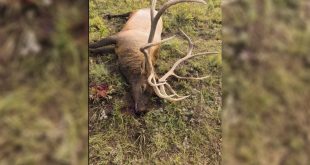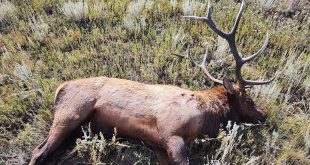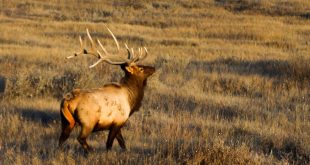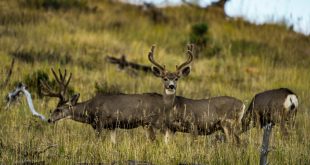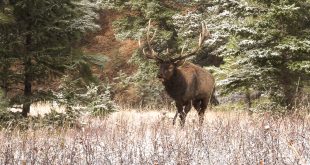
Bowhunting elk is an ever-evolving game from the start of the season to the end. Many tactics work, but many only work for a certain part of the season or just a couple days. For example, bulls are easier to call in during certain times of the season or if they are in a certain mood. You can encounter a bull one day that will not have anything to do with calling, and the next day, he’s mouth–open running in to you. Cow calling can work well and so can bugling. But do you have the skill to know how to find them or hunt them when they go silent? Or when they aren’t rutting at all?
Sitting on water may only work when it’s hot out, but I do know guys who kill elk over water holes out of tree stands. And then there are guys who like the spot–and–stalk type of hunting for elk. But what if you find yourself hunting thick country where glassing is useless? So, where do you go from here when your tactic of choice isn’t working?
As an elk hunter, this is why it is so important to hunt a variety of species, which I consider “cross-training” for elk hunting. Ultimately, the more you bowhunt other animals, the more you are putting tools in your tool box, and you will be surprised how you can apply your experience from many different species to being a better and more effective elk hunter.
Hunters ask me all the time, “Are you an elk or a mule deer guy?” For me, this is a very tough choice, but elk in September is what I cut my teeth on, so I always revert to elk. When I was 14 years old, I had my first encounter with a big bull in September, and I haven’t looked back. If anything, my passion for bowhunting elk gets stronger and stronger as the years go by.
Honestly, I don’t even know what life is like without bowhunting elk in September. As far as I’m concerned, if the name of my favorite month changed to “Elktember,” it would be more fitting. As my bowhunting career advances, I find myself planning hunts around my elk hunts, as they always take priority. When I’m not hunting elk, I’m hunting species that are similar to elk, as that style of hunting complements elk hunting. You’ll start to see a pattern here. It’s all connected. And when it’s hunting season and I’m not hunting elk, I’m guiding elk hunters or hunting with buddies for, you guessed it, elk. My world revolves around elk!
Cross-training for elk hunting
Let’s take a look from 30,000 feet at “cross–training” for elk hunting. I constantly have the desire to gain more knowledge about elk and bowhunting, and once you start hunting, you start to see the resemblance that many big game hunts like red deer, fallow and axis have to elk hunting. Let’s start with red stag in New Zealand. The whole reason I had an interest in bowhunting New Zealand is because the resemblance red deer have to elk. I wanted to do it the hard way—public land during the roar on the heavily–hunted North Island. This was jungle-style hunting, which I least prefer when it comes to elk hunting. But the harder, the better as far as I’m concerned. However, if the timing was right, and if I caught the rut or “the roar” as they call it, it would be good. Just like hunting elk in the “thicks.” Six miles in, lots of rain, lots of hunters, stags were vocal and harvests happened. Highly–pressured red stag act just like elk on general areas back home. Most roaring is done at night with some in the mornings and evenings on the good days. It was just like I was elk hunting back home, maybe even more difficult. I embraced the difficult conditions because I knew, ultimately, it would make elk hunting seem easier.
Now let’s look at fallow and axis deer. Australia has both species, and both rut similar to elk—stags are vocal and up on their feet more in the mornings and evenings rutting and checking does. Stags push does from bedding to feeding areas in the morning and vice versa in the evenings, being most vocal when they’re on the move. Just like elk! This is more so the case with fallow deer than axis, as their movements seem a bit more random because the abundance of feed and water. However, during dry times of the year, axis movement is more predictable because their movement revolves more around water. That goes for any species. I don’t mind hunting dry conditions, as deer and elk movements are more predictable and can be patterned more easily.
Also like elk, both species can be called in, especially fallow. When I was in Australia, fallow bucks were croaking (buck calls) often all night, with activity dwindling shortly after daylight and as they were headed back to their bedding area … you guessed it, just like elk! So, my tactics for fallow were just like hunting elk, too. As I have painted the picture here, you can see that fallow and axis are like hunting miniature elk and are perfect targets to get some “elk hunting” in during the month of April in the wild South Pacific.
Let’s move a little closer to home. There are plenty of different seasons and animals you can hunt and use as cross-training for elk season. First, is spot-and-stalk bear hunting. This allows you to focus on your glassing skills and ability to find and use master vantage points and practice patience. Then there is pronghorn antelope hunting. Tags can be easy to come by if you want to hunt bad enough, and of course, they will challenge you in all the obvious ways, but most importantly, pronghorn will stretch your archery skills. You better be fine-tuned with your bow, as shots out to 60 or 70 yards are common. Once you get a few spot–and–stalk antelope kills under your belt, you have given yourself a huge advantage as a bowhunter, as every other animal I’ve hunted is easier to kill via spot–and–stalk than an antelope.
Then, there’s mule deer. Specifically, early–season high–country mule deer, which are considered to be the ultimate by many bowhunters. A hunt like this will test you in every way possible and to top it off, mule deer aren’t vocal. Master vantage points, early mornings and late evenings spent glassing, and patience are the name of the game when it comes to finding a great buck. Just like spot–and–stalk spring bear hunting, time behind your glass makes up most of your time hunting. This gives you opportunity to analyze animals and take note of their movements, their direction, what time they started feeding and where they’re going. The intense attention to detail and skill it takes to be a successful high–country mule deer hunter carries over to elk hunting in a big way and will make elk hunting feel almost easier, besides the packout of course!
So, take this information and apply it your elk area or maybe an elk area you want to get to know. Start bowhunting deer there, and use those early archery seasons to scout for elk and see what kind of bulls are in the area. Honestly, I have found some of my best elk areas when I was hunting velvet mule deer. On top of that, August is the best time of year to “take inventory” of the bucks and bulls in your hunting area. They are in full velvet at this time and will spend more time in the open this time of year than any other month during hunting season.
I promise you this: If you start “cross–training” for bowhunting elk, you’ll have a big leg up when it’s time to chase after those bugling bulls of September.
TRAIN HARD ENOUGH THIS IS WHAT YOU CAN SET YOURSELF UP FOR
 Eastmans' Official Blog | Mule Deer, Antelope, Elk Hunting and Bowhunting Magazine | Eastmans' Hunting Journals
Eastmans' Official Blog | Mule Deer, Antelope, Elk Hunting and Bowhunting Magazine | Eastmans' Hunting Journals
